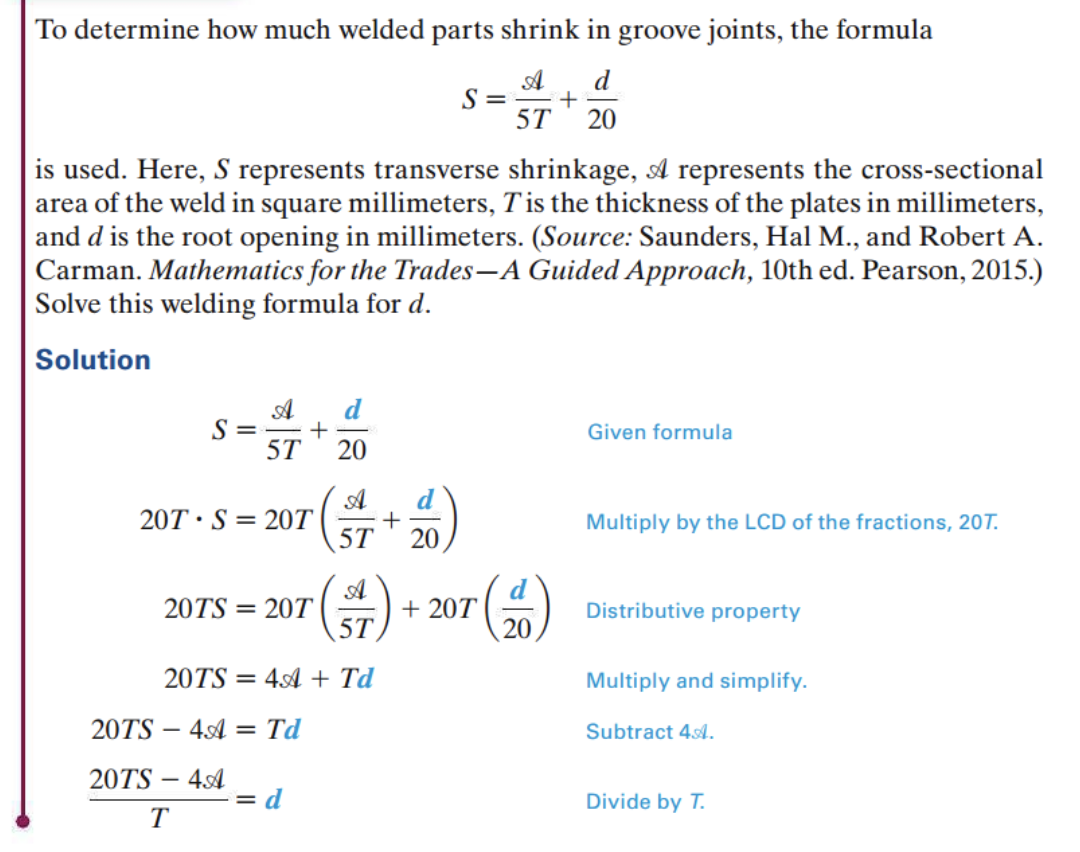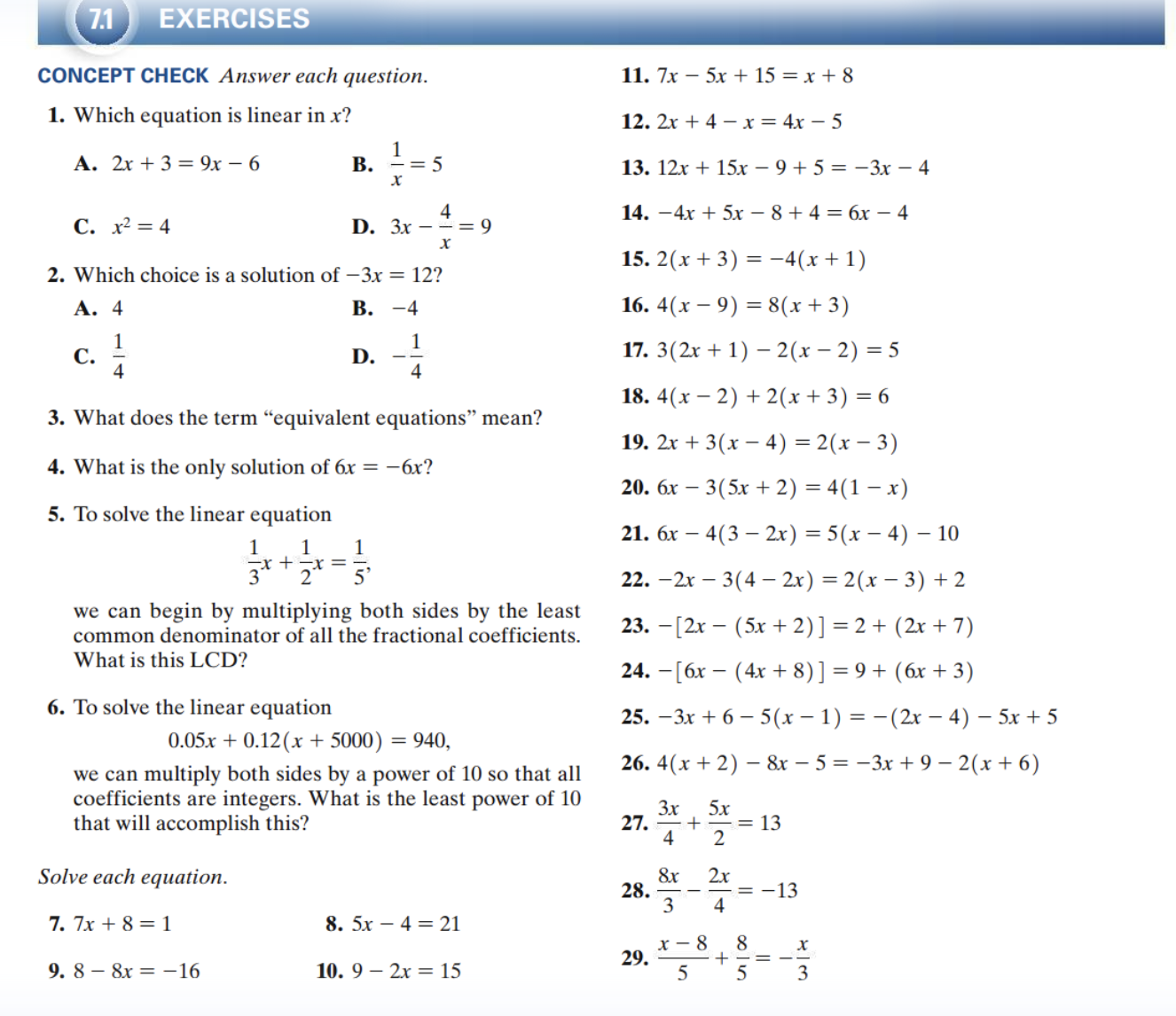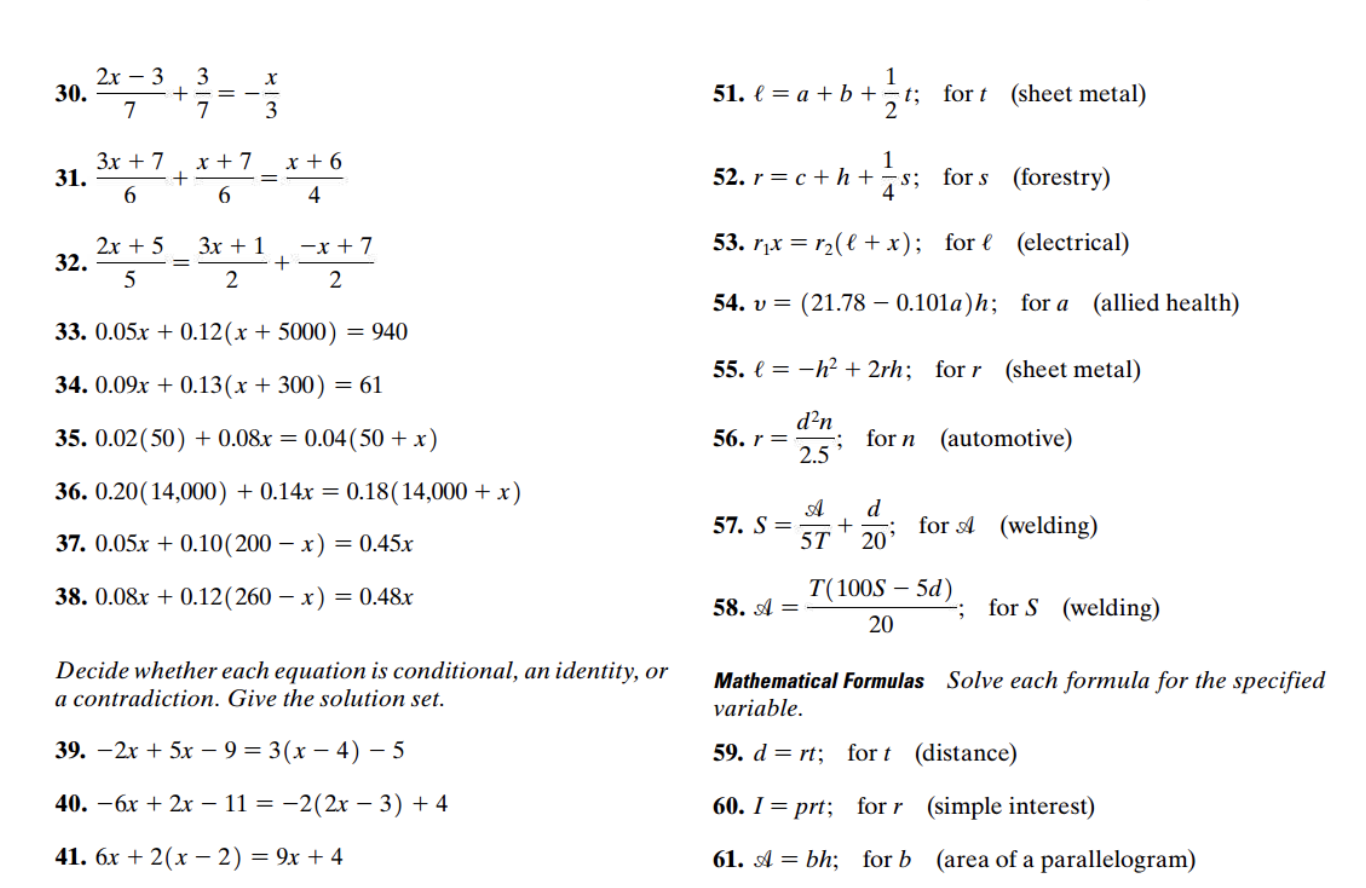[Func-Num] 7.1 Special Kinds of Linear Equations
Categories: Func-Num
📋 This is my note-taking from what I learned in the class “Math175-002 Functions & Number Systems”
Special Kinds of Linear Equations
| Type | Number of Solutions | Final Line When Solving |
|---|---|---|
| Conditional | One | Final line is x = a number |
| Identity | Infinite; solution set {all real numbers} | Final line is True statement, such as 0 = 0. |
| Contradiction | None; solution set ∅ | Final line is False statement, such as 0 = 1. |
Example: Conditional
Solve 5x - 9 = 4(x - 3).
| Solution | |
|---|---|
| 5x - 9 = 4(x - 3) | Original equation |
| 5x - 9 = 4x - 12 | Distributive property |
| 5x - 9 - 4x = 4x - 12 - 4x | Subtract 4x |
| x - 9 = -12 | Combine like terms |
| x - 9 + 9 = -12 + 9 | Add 9 |
| x = -3 | Solution set {-3} |
The solution set has one element, so 5x - 9 = 4(x - 3) is a “conditional equation”.
Example: Identity
Solve 5x - 15 = 5(x - 3).
| Solution | |
|---|---|
| 5x - 15 = 5(x - 3) | Original equation |
| 5x - 15 = 5x - 15 | Distributive property |
| 0 = 0 | Subtract 5x and add 15 |
The final line, 0=0, indicates that the solution set is {all real numbers}, and the equation 5x - 15 = 5(x - 3) is an “identity”. (Note: The first step yielded 5x - 15 = 5x - 15, which is true for all values of x, implying an identity there.)
Example: Contradiction
Solve 5x - 15 = 5(x - 4).
| Solution | |
|---|---|
| 5x - 15 = 5(x - 4) | Original equation |
| 5x - 15 = 5x - 20 | Distributive property |
| 5x - 15 - 5x = 5x - 20 - 5x | Subtract 5x |
| -15 = -20 | False |
Because the result, -15 = -20, is false, the equation has no solution. The solution set is ∅, and the equation is a “contradiction”.
Literal Equations and Formulas
An equation involving variables (or letters), such as cx+d=e, is called a “literal equation”. The most useful examples of literal equations are formulas. The solution of a problem in algebra often depends on the use of a mathematical statement or “formula” in which more than one letter is used to express a relationship.
Examples of formulas

In some cases, a formula must be solved for one of its variables. This process is called “solving for a specified variable”. The steps used are similar to those used in solving linear equations.
Solving for a Specified Variable
When you are solving for a specified variable, the key is to treat that variable as if it were the only one. Treat all other variables like numbers (constants).
-
- Step 1
- If the equation contains fractions, multiply both sides by the LCD to clear the fractions.
-
- Step 2
- Transform so that all terms with the specified variable are on one side and all terms without that variable are on the other side.
- If necessary, use the distributive property to combine the terms with the specified variable.
-
- Step 3
- Divide each side by the factor that is the coefficient of the specified variable. (Divide both sides by the factor that is multiplied by the specified variable.)
Example: Solving for a Specified Variable
Solve the formula “P = 2L + 2W” for L.
| Solution | |
|---|---|
| P – 2W = 2L + 2W – 2W | Subtract 2W |
| P – 2W = 2L | Combine like terms |
| \({P – 2W} \over {2}\) = \({2L} \over {2}\) | Divide by 2 |
The result is
- \({P – 2W} \over {2}\) = L
- \({P} \over {2}\) - W = L

Models
An equation or an inequality that expresses a relationship among various quantities is an example of a “mathematical model”. The relationship between the Fahrenheit and Celsius temperature scales is an example of a linear model.
A mathematical model is an equation (or inequality) that describes the relationship between two quantities. A linear model is a linear equation.
Example: Using the Formulas for Fahrenheit and Celsius
The relationship between degrees Celsius (C) and degrees Fahrenheit (F) is “modeled by the linear equation” “F = 1.8C + 32.”
What Celsius degree corresponds to a Fahrenheit reading of 50°F?
| Solution | |
|---|---|
| Because F = 50, the equation becomes | 50 = 1.8C + 32 |
| 500 = 18C + 320 | Multiply by 10 |
| 180 = 18C | Subtract 320 |
| C = 10 | Divide by 18 |
Therefore, a reading of “50 degrees Fahrenheit” corresponds to a reading of “10 degrees Celsius”.
Exercise
Section. 7-1: 1 – 31, 51 – 61 (odds)

Answer each question.
-
- 1: Which equation is linear in x ?
-
- A. 2x + 3 = 9x -6 → ○
-
- B. 1/x = 5 → ✕
-
- C. x2 = 4 → ✕
-
- D. 3x - 4/x = 9 → ✕
- 3: What does the term “equivalent equations” mean? → They have the same solution set.
- 5: To solve the linear equation \({1}x \over {3}\) + \({1}x \over {2}\) = \({1} \over {5}\) we can begin by multiplying both sides by the least common denominator of all the fractional coefficients. → What is this LCD? → 30
Solve each equation.
- 7: Solution set x is -1
- 9: Solution set x is 3
- 11: Solution set x is -7
- 13: Solution set is empty set, and the equation is “Contradiction”
- 15: Solution set x is -5/3
- 17: Solution set x is -1/2
- 19: Solution set x is 2
- 21: Solution set x is -2
- 23: Solution set x is 7
- 25: Solution set x is 2
- 27: Solution set x is 4
- 29: Solution set is empty set, and the equation is “Contradiction”

- 31: Solution set x is -2
Formulas from Trades and Occupations: The formulas here are found in various trades and occupations. Solve each formula for the specified variable. (Sources: Saunders, Hal M., and Robert A. Carman. Mathematics for the Trades—A Guided Approach, 10th ed. Pearson, 2015; Timmons, Daniel L., and Catherine W. Johnson. Math Skills for Allied Health Careers. Pearson, 2008.)
- 51: t = 2(l - a - b)
- 53: l = \({r_1}x \over {r_2}\) - x
- 55: r = \({l + h^2} \over {2h}\)
- 57: A = 5T(S - \({d} \over {20}\) )
Mathematical Formulas: Solve each formula for the specified variable.
- 59: t = \({d} \over {r}\)
- 61: b = \({A} \over {h}\)

Leave a comment